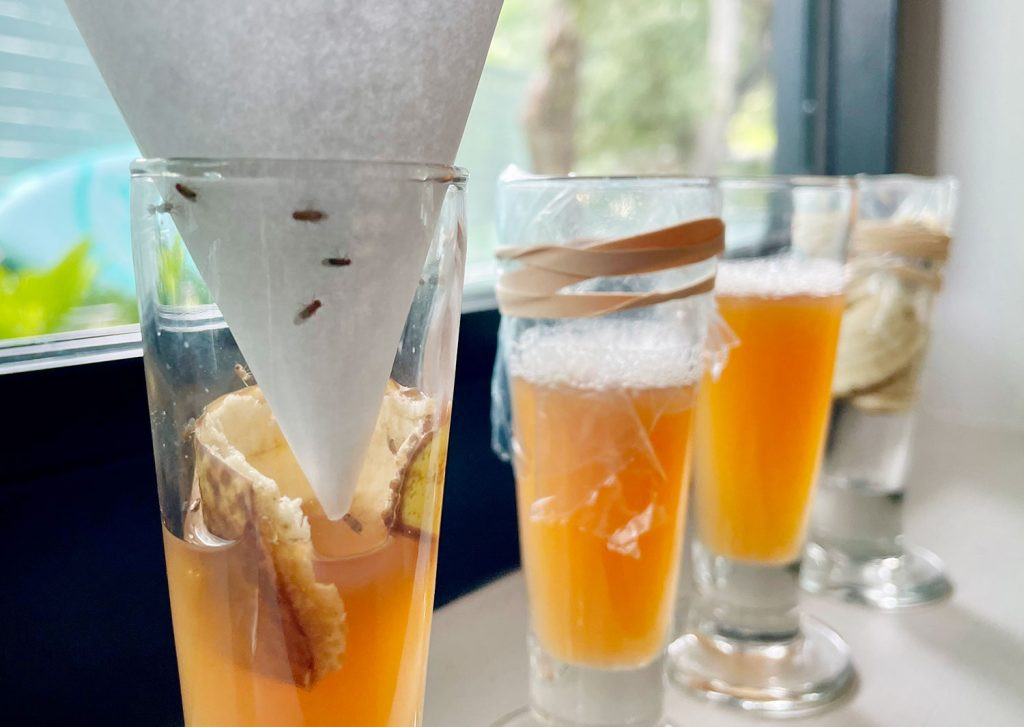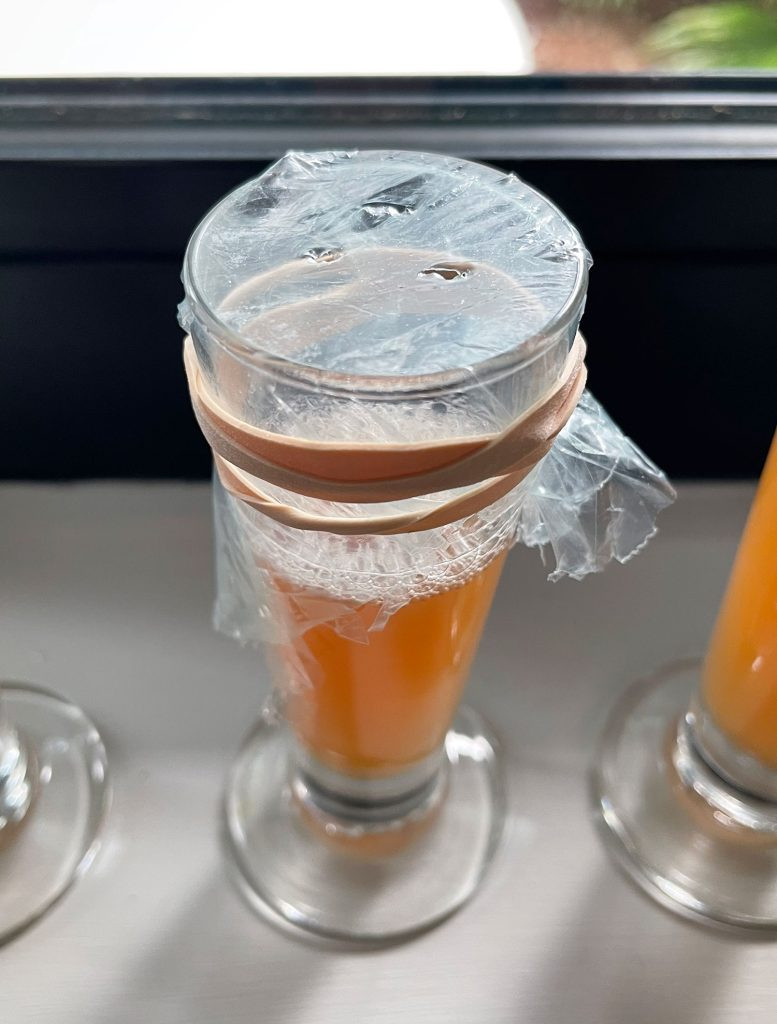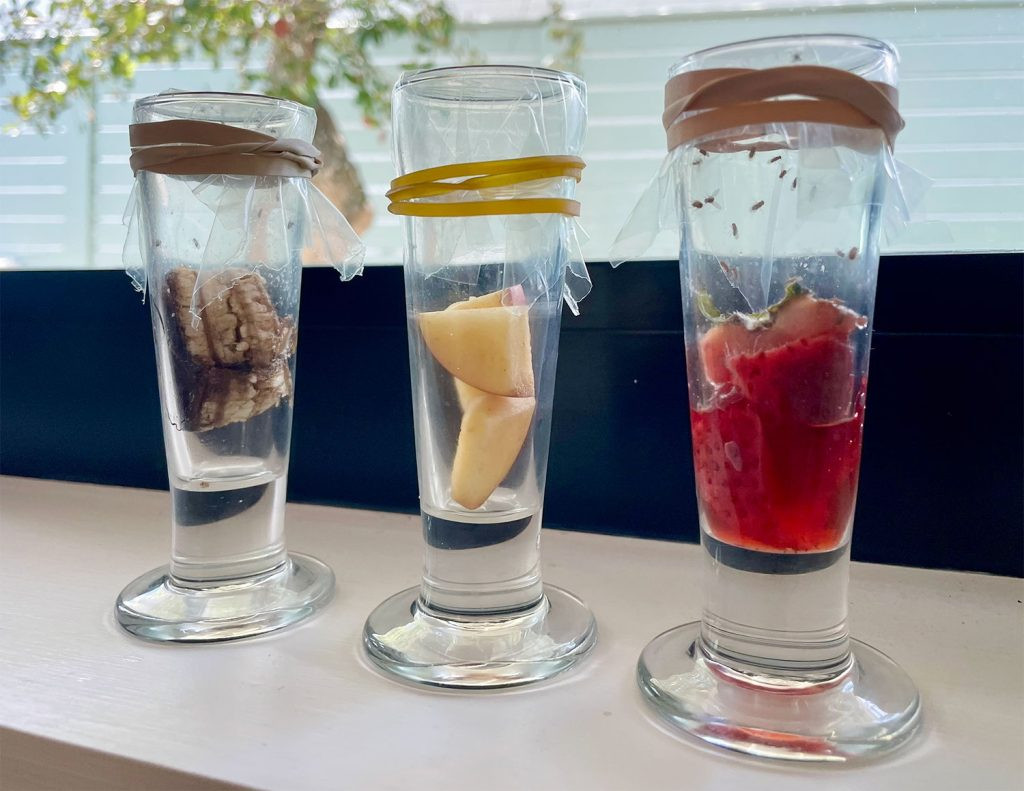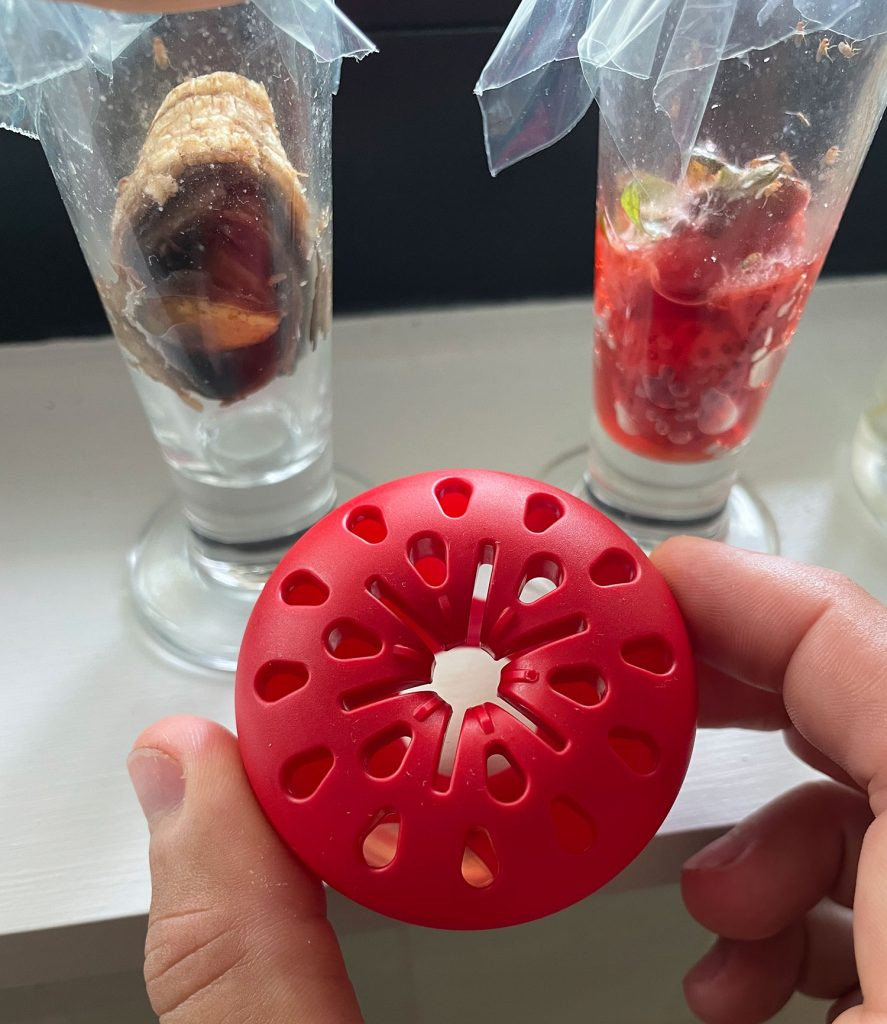Are you battling a swarm of tiny, annoying fruit flies in your kitchen? Getting rid of fruit flies effectively is possible with the right approach, and at flyermedia.net, we’re here to help you reclaim your space. Using simple, effective traps and preventative measures, you can eliminate these pests and keep them from returning.
1. What Exactly Are Fruit Flies?
Fruit flies are small, winged insects that belong to the Drosophilidae family, commonly found buzzing around ripe fruits and vegetables. They are attracted to the sweet smell of fermenting sugars, making your kitchen a prime target, especially during the warmer months. They are tiny, typically about 1/8 inch long, and are often tan or brownish with red eyes.
1.1 Why Are Fruit Flies Attracted to My Home?
Fruit flies are lured into your home by the irresistible aroma of ripe or rotting fruits and vegetables. According to research from the University of California, Riverside, even a small amount of decaying organic matter is enough to attract these pests, as it serves as a breeding ground. These flies can also be drawn to:
- Fermenting liquids such as beer, wine, and vinegar
- Sugary spills that have not been cleaned
- Damp areas like sink drains and garbage disposals
1.2 How Quickly Can a Few Fruit Flies Become a Big Problem?
Fruit flies have a rapid reproduction rate. Females can lay hundreds of eggs near fermenting substances, and these eggs can hatch in as little as 24 hours, according to the USDA. This rapid life cycle means that a few fruit flies can quickly turn into a full-blown infestation.
 Fruit Flies Trapped In DIY Funnel Trap Method
Fruit Flies Trapped In DIY Funnel Trap Method
1.3 How Do I Tell Fruit Flies Apart From Other Pests?
Fruit flies are commonly confused with other small flying insects, such as fungus gnats and drain flies. Distinguishing between them is essential for effective pest control.
| Feature | Fruit Flies | Fungus Gnats | Drain Flies |
|---|---|---|---|
| Appearance | Small, tan or brownish with red eyes | Small, dark, resemble tiny mosquitoes | Small, fuzzy, moth-like appearance |
| Common Location | Near ripe fruit, spills, and sweet items | Near houseplants and damp soil | Near drains, sinks, and sewage systems |
| Attracted To | Fermenting sugars | Damp soil and decaying organic matter | Sewage and organic matter in drains |
If you are uncertain, setting up a simple fruit fly trap can help you identify the pest you are dealing with based on what it attracts.
2. What Are Some Effective DIY Fruit Fly Traps?
Tired of those annoying fruit flies buzzing around your kitchen? You can create effective traps using common household items to eliminate these pests without harsh chemicals. Here are several proven DIY methods:
2.1 The Classic Apple Cider Vinegar Trap
This trap uses the strong scent of apple cider vinegar to lure fruit flies into a container where they become trapped and drown.
Instructions:
- Gather Materials:
- A small jar or cup
- Apple cider vinegar
- Dish soap
- Prepare the Trap:
- Pour about 2 inches of apple cider vinegar into the jar.
- Add a few drops of dish soap (this breaks the surface tension, ensuring the flies sink).
- Placement:
- Place the trap in areas where you frequently see fruit flies, such as near fruit bowls or trash cans.
- Maintenance:
- Replace the mixture every few days or when it becomes full of flies.
Why it Works: According to a study by Clemson University, fruit flies are highly attracted to the acetic acid in apple cider vinegar, making it an effective lure.
2.2 The Funnel Trap
The funnel trap directs fruit flies into a container they can’t escape from, using a paper funnel and a bait.
Instructions:
- Gather Materials:
- A plastic bottle or jar
- Paper or cardstock
- Tape
- Bait (apple cider vinegar, overripe fruit)
- Create the Funnel:
- Roll the paper into a cone shape with a small opening at the bottom.
- Tape the cone to secure its shape.
- Assemble the Trap:
- Place the funnel inside the bottle or jar with the narrow opening facing down.
- Add the bait to the bottom of the container.
- Placement:
- Place the trap in areas with high fruit fly activity.
- Maintenance:
- Empty the trap regularly and replenish the bait as needed.
Expert Tip: A narrow funnel opening is critical to prevent the flies from escaping.
2.3 The Plastic Wrap Trap
This trap uses plastic wrap to create a barrier that’s easy for fruit flies to enter but difficult to exit.
Instructions:
- Gather Materials:
- A jar or cup
- Plastic wrap
- Rubber band
- Toothpick
- Bait (apple cider vinegar, overripe fruit)
- Prepare the Trap:
- Place the bait in the jar.
- Cover the opening tightly with plastic wrap and secure it with a rubber band.
- Use a toothpick to poke a few small holes in the plastic wrap.
- Placement:
- Place the trap in areas where fruit flies are present.
- Maintenance:
- Replace the plastic wrap and bait as needed.
Pro Tip: Make sure the holes are small enough to prevent easy escape but large enough for the flies to enter.
 DIY Fruit Fly Trap With Apple Cider Vinegar And Plastic
DIY Fruit Fly Trap With Apple Cider Vinegar And Plastic
2.4 The Rotting Fruit Trap
Leverage fruit flies’ natural attraction by using overripe fruit as bait in a trap.
Instructions:
- Gather Materials:
- A jar or container
- Overripe fruit (banana peel, apple slice, strawberry)
- Plastic wrap or paper funnel
- Assemble the Trap:
- Place the overripe fruit in the jar.
- Cover the jar with plastic wrap, securing it with a rubber band, and poke small holes. Alternatively, use a paper funnel.
- Placement:
- Place the trap in areas where fruit flies are common.
- Maintenance:
- Replace the fruit every day or two to prevent unwanted smells and maintain effectiveness.
Why This Works: Fruit flies are naturally drawn to the scent of fermenting fruit, making this trap highly effective.
2.5 Dish Soap Trap
Dish soap reduces the surface tension of the liquid, causing fruit flies to drown upon contact.
Instructions:
- Gather Materials:
- A shallow dish or bowl
- Apple cider vinegar or wine
- Dish soap
- Prepare the Trap:
- Fill the dish with apple cider vinegar or wine.
- Add a few drops of dish soap and gently mix.
- Placement:
- Place the dish in areas infested with fruit flies.
- Maintenance:
- Replace the solution every few days.
Additional Tip: The soap disrupts the surface tension, making it difficult for the flies to escape once they land on the liquid.
3. Which Baits Work Best for Fruit Fly Traps?
Choosing the right bait can significantly improve the effectiveness of your fruit fly traps. Different baits appeal to fruit flies for various reasons, and experimenting can help you find the best option for your situation.
3.1 Apple Cider Vinegar (ACV): The Go-To Bait
Apple cider vinegar is one of the most popular and effective baits for fruit fly traps. Its sweet, fermented scent is highly attractive to these pests.
- Why it Works: The acetic acid in ACV mimics the scent of fermenting fruit, which is a primary attractant for fruit flies.
- How to Use: Pour a small amount of ACV into your trap container. Adding a few drops of dish soap can help break the surface tension, trapping the flies more effectively.
3.2 Overripe Fruit: Mimicking Their Natural Food Source
Using overripe fruit directly targets the fruit flies’ natural feeding habits. Fruits like bananas, strawberries, and peaches that are past their prime emit strong, enticing odors.
- Why it Works: As fruit ripens and begins to decay, it releases ethanol, which fruit flies find irresistible.
- How to Use: Place a piece of overripe fruit in your trap. For plastic wrap traps, ensure the fruit is accessible through the small holes. For funnel traps, position the fruit at the bottom of the container.
3.3 Wine and Beer: Fermented Delights
Old wine or beer can serve as excellent bait due to their fermented nature, which mimics the decaying fruit that fruit flies love.
- Why it Works: The fermentation process creates compounds that attract fruit flies, similar to those found in rotting fruit.
- How to Use: Pour a small amount of old wine or beer into your trap. Dish soap can be added to ensure the flies drown.
3.4 A Combination of Baits: The Ultimate Lure
Combining different baits can sometimes yield better results than using a single attractant. For example, mixing ACV with a piece of overripe fruit can draw in a larger number of fruit flies.
- Why it Works: By offering multiple attractants, you increase the likelihood of luring in flies that might be more attracted to one scent over another.
- How to Use: Place a piece of overripe fruit in a trap with ACV. Monitor which combination seems to be more effective and adjust accordingly.
 Fruit Fly Traps With Different Rotten Fruit Baits
Fruit Fly Traps With Different Rotten Fruit Baits
3.5 Experimenting with Different Fruits: Finding What Works Best
Different fruits will attract more flies. A study by the University of Florida showed that fruit flies are more attracted to certain types of rotting fruit based on their sugar content and emitted volatiles.
4. Are Store-Bought Fruit Fly Traps Effective?
When DIY methods don’t cut it, or you prefer a more discreet solution, store-bought fruit fly traps are worth considering. These traps are designed to effectively lure and capture fruit flies, often with specialized attractants and designs.
4.1 Popular Store-Bought Traps
Several highly-rated fruit fly traps are available on the market, each with unique features and attractants.
| Trap Type | Description | Key Features | Pros | Cons |
|---|---|---|---|---|
| Terro Fruit Fly Trap | Apple-shaped trap with a liquid attractant | Non-toxic, long-lasting, and discreet design | Easy to use, effective attractant, and visually appealing | May not be as fast-acting as some DIY traps |
| KATCHY Indoor Insect Trap | UV light trap with a sticky glue board | Attracts flies with UV light, no chemicals, safe for pets and children | Effective for various flying insects, safe, and easy to maintain | Requires electricity, glue boards need replacement, and may not be as effective in daylight |
| Trappify Fruit Fly Trap | Small, discreet traps with a powerful liquid attractant | Odor-free, non-toxic, and easy to place | Effective attractant, discreet design, and easy to use | Can be more expensive than DIY options |
| RESCUE! Fruit Fly Trap | Uses a non-toxic, food-based lure that attracts and traps fruit flies | Effective lure, easy to assemble, and long-lasting | Highly effective attractant, easy to set up, and can be used in multiple locations | May have a noticeable odor |
4.2 How Store-Bought Traps Work
Store-bought traps typically work in one of two ways:
- Lure and Capture: These traps use a specific attractant to lure fruit flies into the device, where they become trapped and cannot escape. The attractant may be a liquid, gel, or a sticky substance.
- UV Light Traps: These traps emit ultraviolet (UV) light, which attracts a variety of flying insects, including fruit flies. The insects are then captured by a sticky glue board or electrocuted.
4.3 Comparing DIY vs. Store-Bought Traps
The choice between DIY and store-bought traps depends on several factors, including cost, convenience, and effectiveness.
- Cost: DIY traps are generally more cost-effective, as they use household items. Store-bought traps can be more expensive upfront but may last longer.
- Convenience: Store-bought traps are more convenient, requiring minimal setup. DIY traps require more preparation and monitoring.
- Effectiveness: Both DIY and store-bought traps can be effective, but the results can vary based on the specific trap and the environment.
 Terro Fruit Fly Apple Trap With No Fruit Flies In It
Terro Fruit Fly Apple Trap With No Fruit Flies In It
4.4 Choosing the Right Trap for Your Needs
Consider the following factors when deciding between DIY and store-bought traps:
- Infestation Level: For minor infestations, DIY traps may suffice. For more severe problems, store-bought traps may be more effective.
- Aesthetics: Store-bought traps are often designed to be discreet, while DIY traps may be less visually appealing.
- Ingredients: If you prefer to avoid chemicals, opt for DIY traps with natural attractants or store-bought traps with non-toxic lures.
5. How Can You Prevent Fruit Flies From Invading Your Home?
Prevention is crucial in keeping fruit flies at bay. Implementing a few simple practices can significantly reduce the likelihood of an infestation.
5.1 Proper Food Storage
Storing food correctly is the first line of defense against fruit flies. These pests are attracted to the odors emitted by ripening and decaying produce.
- Refrigerate Produce: Store fruits and vegetables that ripen quickly, such as bananas, tomatoes, and peaches, in the refrigerator. Cold temperatures slow down the ripening process and reduce the release of attractive odors.
- Use Airtight Containers: Keep fruits and vegetables in airtight containers or resealable bags to contain their odors.
- Regularly Inspect Produce: Check your fruit bowl regularly for overripe or decaying items. Discard any spoiled produce immediately.
5.2 Maintaining Cleanliness
Cleanliness is essential to eliminate potential food sources for fruit flies.
- Clean Spills Immediately: Wipe up any spills of sugary liquids, fruit juices, or alcoholic beverages right away. These substances are highly attractive to fruit flies.
- Empty Trash Regularly: Empty your kitchen trash can frequently to prevent food scraps from accumulating and attracting flies.
- Clean Countertops and Surfaces: Wipe down countertops, tables, and other surfaces daily to remove any food residue.
5.3 Proper Waste Disposal
How you handle your waste can significantly impact the presence of fruit flies.
- Use a Sealed Trash Can: Ensure your trash can has a tight-fitting lid to prevent odors from escaping and attracting flies.
- Clean Trash Cans Regularly: Wash your trash cans regularly with soap and water to remove any lingering food residue.
- Compost Responsibly: If you compost, keep your compost bin away from your home and ensure it is properly sealed to prevent odors from attracting fruit flies.
5.4 Maintaining Drains
Drains can become breeding grounds for fruit flies due to the accumulation of organic matter.
- Flush Drains Regularly: Flush your drains regularly with hot water and vinegar to clear out any buildup of organic material.
- Use Drain Cleaners: Periodically use enzymatic drain cleaners to break down organic matter in your drains.
- Clean Garbage Disposals: Clean your garbage disposal regularly by grinding ice cubes and lemon or lime peels to remove food particles and odors.
5.5 Additional Tips
Here are a few more tips to keep fruit flies away:
- Inspect Incoming Produce: Check fruits and vegetables for signs of fruit fly eggs or larvae before bringing them into your home.
- Ventilate Your Kitchen: Proper ventilation can help reduce humidity and prevent the buildup of odors that attract fruit flies.
- Use Screens on Windows and Doors: Ensure your windows and doors have screens to prevent fruit flies from entering your home from the outside.
By following these preventive measures, you can create an environment that is less attractive to fruit flies and significantly reduce the chances of an infestation.
6. What Are the Common Mistakes People Make When Trying to Get Rid of Fruit Flies?
Even with the best intentions, some common mistakes can hinder your efforts to eliminate fruit flies. Understanding these pitfalls can help you avoid them and achieve better results.
6.1 Not Identifying the Source
One of the most common mistakes is failing to locate and eliminate the primary breeding source of the fruit flies.
- Why It Happens: People often focus on trapping adult flies without addressing where they are breeding.
- The Solution: Thoroughly inspect your kitchen and surrounding areas for overripe fruit, spills, or decaying organic matter. Clean or remove any potential breeding sites.
6.2 Ineffective Trap Placement
Placing traps in the wrong locations can significantly reduce their effectiveness.
- Why It Happens: Traps may be placed in areas with low fruit fly activity or away from their primary flight paths.
- The Solution: Place traps in areas where you frequently see fruit flies, such as near fruit bowls, trash cans, and sinks. Consider placing multiple traps in different locations to maximize coverage.
6.3 Using the Wrong Bait
Using an ineffective bait can prevent fruit flies from being attracted to your traps.
- Why It Happens: Not all baits are equally attractive to fruit flies. Some may be too weak or not appealing enough.
- The Solution: Experiment with different baits such as apple cider vinegar, overripe fruit, wine, or beer. A combination of baits can also be more effective.
6.4 Neglecting Proper Cleaning
Failing to maintain a clean environment can undermine your trapping efforts by providing alternative food sources for fruit flies.
- Why It Happens: Spills, food residue, and dirty drains can attract and sustain fruit fly populations.
- The Solution: Clean up spills immediately, empty trash cans regularly, and ensure your drains are clean.
6.5 Not Maintaining Traps
Traps that are not properly maintained can become less effective or even counterproductive.
- Why It Happens: Traps may become full of flies, or the bait may evaporate or become less attractive over time.
- The Solution: Replace the bait and clean the trap every few days. This ensures the trap remains effective and continues to attract fruit flies.
6.6 Underestimating the Infestation
Underestimating the severity of the infestation can lead to half-hearted efforts that fail to eliminate the problem.
- Why It Happens: People may assume a few fruit flies are not a big deal and delay taking action.
- The Solution: Take immediate action at the first sign of fruit flies. Implement a comprehensive strategy that includes trapping, source elimination, and prevention measures.
6.7 Giving Up Too Soon
Some people give up on their fruit fly control efforts too quickly, assuming the problem is too difficult to solve.
- Why It Happens: Eliminating fruit flies can take time and persistence.
- The Solution: Be patient and persistent. It may take several days or even weeks to fully eliminate a fruit fly infestation. Continue to implement your strategy and adjust as needed.
By avoiding these common mistakes, you can significantly improve your chances of successfully eliminating fruit flies and preventing future infestations.
7. How Can Flyermedia.net Help You With Your Aviation Interests?
While you’re tackling those pesky fruit flies, did you know that flyermedia.net offers a wealth of information for aviation enthusiasts? Whether you dream of becoming a pilot, want to stay updated on the latest aviation news, or are seeking career opportunities in the industry, we’ve got you covered.
7.1 Pilot Training Programs
Interested in learning to fly? flyermedia.net provides a comprehensive list of accredited flight schools in the USA, including top institutions like Embry-Riddle Aeronautical University located at 600 S Clyde Morris Blvd, Daytona Beach, FL 32114, United States, Phone: +1 (386) 226-6000. Our directory includes details on:
- Flight School Ratings: Find schools with top ratings and reviews.
- Program Details: Learn about various pilot training programs, from private pilot licenses to commercial certifications.
- Financial Aid: Discover financial aid and scholarship opportunities to help fund your training.
7.2 Aviation News and Updates
Stay informed about the latest developments in the aviation world. flyermedia.net delivers up-to-date news on:
- Industry Trends: Stay ahead with insights into emerging trends in the aviation sector.
- Technological Advancements: Learn about the newest technologies shaping the future of flight.
- Regulatory Changes: Keep up with changes in aviation laws and regulations.
7.3 Career Opportunities in Aviation
Looking for a career in aviation? Explore numerous job opportunities on flyermedia.net, including:
- Pilot Positions: Find airline, cargo, and private aviation jobs.
- Engineering Roles: Discover opportunities in aircraft design, maintenance, and aerospace engineering.
- Air Traffic Control: Learn about careers in air traffic management and control.
- Maintenance Technicians: Explore roles in aircraft maintenance and repair.
7.4 Expert Insights and Articles
Gain valuable knowledge from our expert articles and guides. Topics include:
- Aircraft Technology: Understand the mechanics and technology behind modern aircraft.
- Air Safety: Learn about the latest safety protocols and advancements in aviation.
- Travel Tips: Get tips for smoother and more enjoyable air travel experiences.
7.5 Connecting With the Aviation Community
Join a community of aviation enthusiasts on flyermedia.net. Share your passion, learn from others, and stay connected with industry professionals.
By visiting flyermedia.net, you can explore these resources and take the next step in your aviation journey.
8. FAQs About Getting Rid of Fruit Flies
8.1 How Long Does It Take to Get Rid of Fruit Flies?
The time it takes to eliminate fruit flies can vary depending on the severity of the infestation and the effectiveness of your methods. In most cases, you can expect to see a significant reduction in the fruit fly population within a few days to a week. However, complete eradication may take up to two weeks.
8.2 What Attracts Fruit Flies the Most?
Fruit flies are most attracted to the scent of fermenting sugars and ripe or rotting fruits and vegetables. They are also drawn to sugary spills, beer, wine, and vinegar.
8.3 Can Fruit Flies Bite?
No, fruit flies do not bite. They lack the mouthparts necessary to bite or sting. They are primarily a nuisance due to their presence and ability to contaminate food.
8.4 Are Fruit Flies Harmful?
Fruit flies are not directly harmful in the sense that they don’t bite or transmit diseases to humans. However, they can contaminate food by spreading bacteria and other microorganisms.
8.5 How Do Fruit Flies Get into My House?
Fruit flies can enter your home in several ways:
- On Produce: They can hitchhike on fruits and vegetables brought in from the store.
- Through Openings: They can fly in through open windows and doors, especially if attracted by food odors.
- From Outside: They can breed in nearby compost piles or gardens and then migrate indoors.
8.6 Why Are Fruit Flies So Hard to Get Rid Of?
Fruit flies are challenging to eliminate due to their rapid reproduction rate, small size, and ability to breed in various locations. Females can lay hundreds of eggs, and the entire life cycle from egg to adult can be completed in as little as a week.
8.7 Can I Use Vinegar to Get Rid of Fruit Flies?
Yes, vinegar, especially apple cider vinegar, is an effective bait for fruit fly traps. Its sweet, fermented scent attracts fruit flies, luring them into the trap.
8.8 Do Fruit Flies Only Eat Fruit?
While fruit flies are attracted to fruit, they also feed on other sources of fermenting sugars, such as sugary spills, beer, wine, and vinegar. They can also breed in damp, organic matter like that found in drains and garbage disposals.
8.9 Can I Prevent Fruit Flies by Storing Fruit in the Refrigerator?
Yes, storing fruit in the refrigerator can help prevent fruit flies. Cold temperatures slow down the ripening process and reduce the release of odors that attract fruit flies.
8.10 Are There Any Natural Repellents for Fruit Flies?
While there are no foolproof natural repellents, some people have found success using essential oils like peppermint, eucalyptus, or lavender. Placing cotton balls soaked in these oils near fruit bowls or other areas where fruit flies are present may help deter them.
Ready to reclaim your kitchen and keep those fruit flies at bay? Visit flyermedia.net for more helpful tips and resources, and explore your passion for aviation while you’re there!